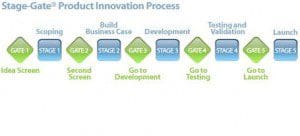Last month, I wrote a posting on how Walmart is reducing its SKU selection to improve merchandising and reduce complexity. In response, Kate Vitasek, founder of Supply Chain Visions, sent me an article she wrote with Eric Tinker and Shawn Bhimani called “Rationalizing SKU Introductions.”
In her email to me, Kate commented that we should “step back and think of [an] alternative approach. What if companies approached the problem from the other angle of ‘Rationalizing SKU Introduction’ [on the front end] vs. ‘SKU Rationalization’ on the back end? If [companies] can attack it on the front end… that will prevent billions of dollars in waste on the back end.”
When you flip this and think about focusing less on cutting the number of SKUs you already have and more on introducing fewer new products to start with, then we enter the realm of product lifecycle management. The article provides data on how incredibly unsuccessful the vast majority of new product introductions (NPIs) are:
- The failure rate of consumer products is 95 percent in the U.S and 90 percent in Europe (Harvard Business Review, Don’t Blame the Metrics, Kevin J. Clancy and Randy L. Stone, June 2005).
- Research shows fewer than two hundred of the hundreds of thousands of products introduced over a recent ten-year period earn sales of more than $15 million a year (The Origin of Brands: How Product Evolution Creates Endless Possibilities for New Brands, Al Ries, 2005).
- Only 45 percent of new products experience an on-time launch, a key driver in the long-term success and future viability of a product (Industry Week, Failure To Launch, Kill Jusko, Sept. 2007).
- At most, only 10 percent of new products are successful after three years (Marketing Management, SURVIVING Innovation, Kevin Clancy and Peter Krieg, April 2003).
Many companies use the stage-gate process to make “Go/No-Go” decisions, using predefined criteria, at defined points in the new product introduction process. To move on to the next stage, teams from different departments must typically complete a prescribed set of related cross-functional tasks at each stage.

I view SKU reduction programs as a form of complexity reduction, a way to decrease the number of ingredients, components, and subassemblies used to make a product. Ideally, in building the business case, the “product definition and analysis” sub-step would include looking at whether parts (or ingredients) commonly used in making other products can also be used in making the new product.
The article urges that the “Testing and Validation” step include a sub-stage—market testing—that companies often omit. Market testing is a trial production of a product before the company does a full roll-out. “Testing gives a company the ability to obtain a better idea of whether or not the product will succeed in the market and meet these goals,” the authors write. “It also offers the added bonus of being able to demonstrate the potential issues of the product’s marketing, packaging sizes, compatibility, etc. Lastly, market testing allows for collecting end-consumer feedback. By using testing, a company can not only ensure that it only delivers products which stand a chance in the market, but it also helps strengthen the full product launch to be as successful as possible.”
However, being more selective about product introductions, which probably reduces the number of SKUs, is not the full story. This may slow the speed with which the “SKU tank” fills up, but it does not empty the tank when it gets too full. Thus, as the authors state, “products should be introduced with the expectation that they have a finite life and are to be actively managed throughout a defined lifecycle. The lifecycle is criteria-based and considers the total effect on the product portfolio as well as the supply chain. In addition to implementing a defined stage gate process to get products to market, leading organizations actively manage the portfolio and have defined exit strategies for every product (emphasis mine).” What we are talking about here goes beyond new product introductions to encompass managing SKU profitability on an ongoing basis.
The stage gate product innovation process is widely known. In contrast, the process for managing SKUs on an ongoing basis – emptying the SKU tank before it gets too full – has not been written about much. What would this process look like? Does your company have a process for managing SKUs on an ongoing basis? We’d love to hear about it.
















